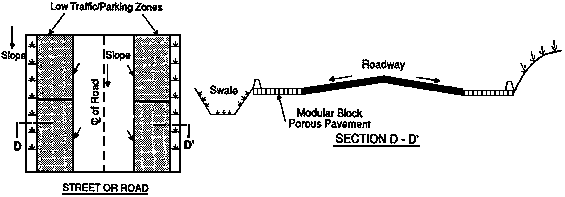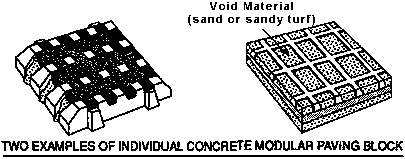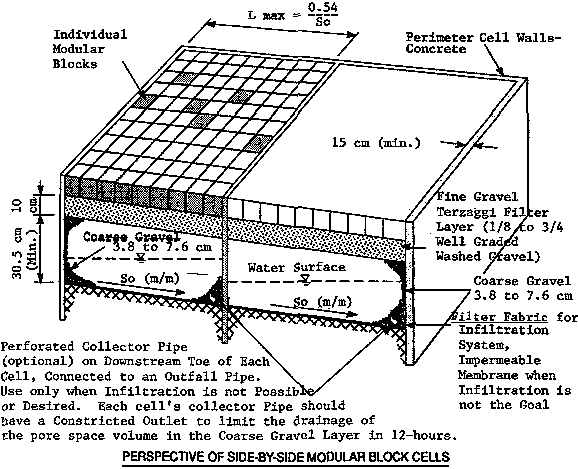Stormwater Best Management Practices in an Ultra-Urban Setting: Selection and Monitoring
Fact Sheet - Porous Pavements
Porous pavements have the potential to be an effective ultra-urban BMP. While conventional pavement results in increased rates and volumes of surface runoff, porous pavements allow some of the stormwater to percolate through the pavement and enter the soil below.
The types of porous pavements used include porous asphalt and concrete surfaces, as well as several types of lattice pavers, which are hollow concrete blocks or stones (Figure 26). Porous pavements work by allowing streets, parking lots, sidewalks, and other impervious covers to retain their natural infiltration capacity while maintaining the structural and functional features of the materials they replace.

Applicability
In many instances porous pavements can be used in place of conventional asphalt or concrete in an ultra-urban environment. They are generally not suited for areas with high traffic volumes or loads. Composite designs that use conventional asphalt or concrete in high-traffic areas adjacent to porous pavements along shoulders or in parking areas have, however, been designed (Figure 27). Generally, porous pavements are most often used in the construction of parking areas for office buildings, recreational facilities, and shopping centers. Other uses include emergency stopping areas, traffic islands, sidewalks, road shoulders, vehicle cross-overs on divided highways, and low-traffic roads. Some porous pavements such as porous asphalt have also been tested for use in highway projects (Hossain and Scofield, 1991). Their use at gas stations, truck stops, and industrial sites is not recommended due to the high risk of groundwater contamination from trace organic compounds (Cahill, undated). As a BMP retrofit option, porous pavement might have limited application because prior disturbance or modification of in situ soil often significantly reduces its infiltration capacity (Schueler et al., 1992).




Porous pavements such as porous asphalt are also effective at reducing hydroplaning, as well as improving wet weather visibility (Stotz and Krauth, 1994). The use of interlocking concrete paving stones on walks and crosswalks can also make them more visible and safer for both drivers and pedestrians, thereby reducing the need for repainting.
Effectiveness
When operating properly, porous pavements are as effective at removing pollutants from stormwater as other infiltration devices. Also like other infiltration BMPs, porous pavements are not designed to sustain a high removal rate for suspended sediment. While initial removal rates for suspended sediment are very high, the removal process causes clogging of the pavement and subsequently reduces its infiltration capacity. As the infiltration capacity decreases, so does the capture and treatment of runoff pollutants. Careful attention to maintenance is necessary to reduce the potential for clogging. In addition, all adjacent areas should be stabilized to prevent sediment from washing onto the pavement surface to prevent premature clogging.
Hossain and Scofield (1991) found that a test section of porous pavement performed satisfactorily over five years. Although a slight decrease in the infiltration rate occurred, both the infiltration rate and storage capacity were above design values. Typical removal rates based on load reductions observed are summarized in Table 17.
Table 17. Pollutant removal effectiveness for porous pavement (%)
| Study |
TSS2 |
TP |
TN |
NO3 |
Metals |
Comments |
| MWCOG (1983) |
95 |
60 |
88 |
- |
99 |
Rainfall |
| Hogland et al. (1987) |
95 |
71 |
-3051 |
-16071 |
33-96 |
Snowmelt |
1 Prior agricultural land use in the area.
2 High loadings of TSS significantly reduce the life expectancy of porous pavement BMPs. |
Siting and Design Considerations
Suitable sites for porous pavements are generally limited to low-traffic areas with a minimum soil infiltration capacity of 7 mm/h (0.27 in/h) (greater than 13 mm/h (0.5 in/h) is preferred). Geotechnical testing of potential installation locations is needed to quantify the infiltration capacity. In siting porous pavement, groundwater contamination can be minimized by ensuring that the depth to the seasonally high water tables is at least 1.2 m (4 ft) below the reservoir layer and that installations are no closer to drinking water wells than 30 m (100 ft). Sites that are probable sources of high contaminant loads, such as gas stations, should be avoided.
Porous pavement installations should also be 30 m (100 ft) upgradient and 3 m (10 ft) downgradient of building foundations. More detailed guidelines for the siting of porous pavements and related design specifications can be found in Evaluation and Management of Highway Runoff Water Quality (Young et al., 1996), and A Current Assessment of Urban Best Management Practices - Techniques for Reducing Non-Point Source Pollution in the Coastal Zone (Schueler et al., 1992). Additional information on existing designs and their effectiveness is available in Stormwater Infiltration (Furgerson, 1994).
The design considerations for porous pavement should be consistent with the concepts of flexible pavement design. These requirements, summarized by Rollings and Rollings (1993), include:
- The use of sufficient pavement thickness to protect the subgrade from being overstressed.
- The use of quality base and subbase materials that can support the applied loads.
- A stable surface that serves as the wearing course for traffic.
- The compaction of all materials to provide strength and to resist densification under traffic.
Standard cross section designs typical of those for porous asphalt and modular paving stones are shown in Figures 28 and 29, respectively.

Figure 29. Modular block porous pavement
(adapted from Urban drainage and Flood Control District, 1992)


Porous pavements using lattice-type pavers or hollow concrete blocks and paving stones have similar construction details. Paving stones, however, can generally be designed to have a much higher load-bearing capacity and therefore have more widespread applicability. Detailed construction information and specifications are generally available from the manufacturers of these products (Florida Concrete and Products Association, 1989; Rollings and Rollings, 1993).
Based on construction experience, Cahill (undated) recommends the inclusion of a perimeter stone filter inlet around the edges of porous pavement installations as a reliable means of ensuring that runoff enters the stone filter reservoir if surface clogging of the pavement occurs. In addition, when specifying the pavement or paver stones it is important to ensure the surface infiltration rate is greater than the peak design rainfall intensity. One source gives this peak design rainfall intensity as the 1-h, 2-year rainfall (Young et al., 1996).
Maintenance Considerations
To maintain the infiltrative capacity of porous pavements such as asphalt, quarterly vacuum sweeping in conjunction with jet hosing or jet hosing alone is recommended (Schueler et al., 1992). Therefore, the installation of porous pavement BMPs in regions that lack the equipment or resources for routine maintenance is not recommended; a high failure rate for porous asphalt installations in Maryland is attributed in part to a lack of routine maintenance (Lindsey et al., 1991). Failures at sites in the Middle Atlantic states have also been attributed to poor site conditions and installation practices (Cahill, undated). In contrast, unmaintained parking areas constructed in 1985 with concrete block pavers had retained an infiltration capacity in excess of 100 mm/h (4 in/h) when inspected in 1994 (Pratt et al., 1995). Pratt et al. (1995) estimated the useful life of these types of permeable surfaces to be between 15 and 20 years. Since paving stones can be lifted and reused, the repair or reconstruction of these surfaces is also expected to be less than that associated with porous asphalt or concrete.
When modular pavements incorporate turf into their void area, normal turf maintenance practices, including watering, fertilization, and mowing might be required (WDOE, 1992). Mowing is not usually necessary in high-traffic areas. In regions were rainfall is infrequent, provisions for watering are required.
Cost Considerations
Costs for porous asphalt are approximately 10 to 15 percent higher than those for regular asphalt; porous concrete is about 25 percent more expensive than regular concrete. Requirements for site preparation or the use of specialized equipment may also increase these costs. The use of modular paving stones can be up to four times as expensive as either regular asphalt or concrete. The higher costs of installation of porous pavements can be offset to some extent by the elimination of curbs, gutters, and storm drains. In some cases this may lower the overall cost for a project (Field et al., 1982). The final economics associated with a particular site are also affected by site-specific conditions, such in situ permeability, and the cost and proximity of gravel supplies.
References
Cahill, T.H. Undated. A Second Look at Porous Pavement/Underground Recharge. Technical Note 21. Technical Notes - Urban Best Management Practices. Cahill Associates, West Chester, PA.
Field, R., H. Masters, and M. Singer. 1982. Porous Pavement: Research; Development; and Demonstration. Transportation Engineering Journal of ASCE, Vol. 108, No. TE3.
Florida Concrete and Products Association. 1989. Pervious Pavement Manual.
Furgerson, B.K. 1994. Stormwater Infiltration. Lewis Publishers, Ann Arbor, MI.
Hossain, M., and L.A. Scofield. 1991. Porous Pavement for Control of Highway Run-off. Final Report. FHWA-AZ91-352. Prepared by Arizona Transportation Research Center, Phoenix, AZ.
Hogland, W., J. Niemczynowice, and T. Wahlan. 1987. The Unit Superstructure during the Construction Period. The Science of the Total Environment (59):411-424.
Lindsey, G., L. Roberts, and W. Page. 1991. Stormwater Management Infiltration Practices in Maryland: A Second Survey. Maryland Department of the Environment, Baltimore, MD.
Metropolitan Washington Council of Governments (MWCOG). 1983. Urban Runoff in the Washington Metropolitan Area: Final Report, Urban Runoff Project, EPA Nationwide Urban Runoff Program. Metropolitan Washington Council of Governments, Washington, DC.
Pratt, C.J., J.D.G. Mantle, and P. A. Schofield. 1995. UK Research into the Performance of Permeable Pavement, Reservoir Structures in Controlling Stormwater Discharge Quantity and Quality. Wat. Sci. Tech., 33(1):63-69.
Rollings, R.S., and M.P. Rollings. 1993. Design Considerations for the Uni Eco-Stone® Concrete Paver. Uni-Group, Palm Beach Gardens, FL.
Schueler, T.R., P.A. Kumble, and M.A. Heraty. 1992. A Current Assessment of Urban Best Management Practices - Techniques for Reducing Non-Point Source Pollution in the Coastal Zone. Metropolitan Washington Council of Governments, Department of Environmental Programs, Anacostia Restoration Team, Washington, D.C.
Stotz, G., and K. Krauth. 1994. The Pollution of Effluents from Pervious Pavements of an Experimental Highway Section: First Results. The Science of the Total Environment (146/147):465-470.
WDOE. 1992. Stormwater Management Manual for the Puget Sound Basin (The Technical Manual). Washington State Department of Ecology, Seattle, WA.
Young, G.K., S. Stein, P. Cole, T. Kammer, F. Graziano, and F. Bank. 1996. Evaluation and Management of Highway Runoff Water Quality. FHWA-PD-96-032. Federal Highway Administration, Office of Environment and Planning.
|

